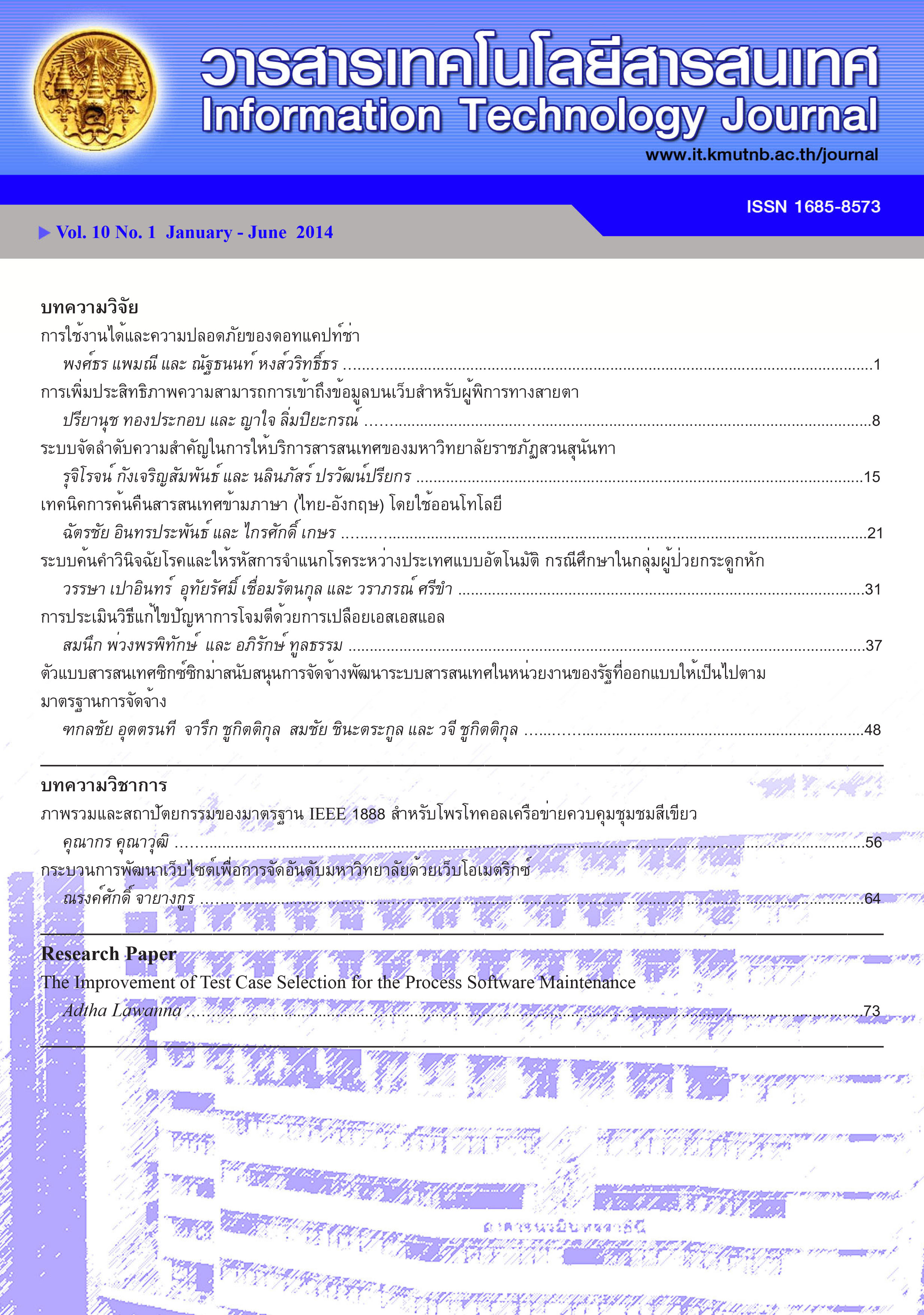ตัวแบบสารสนเทศซิกซ์ซิกม่าสนับสนุนการจัดจ้างพัฒนาระบบสารสนเทศ ในหน่วยงานของรัฐที่ออกแบบให้เป็นไปตามมาตรฐานการจัดจ้าง
Main Article Content
Abstract
การวิจัยครั้งนี้มีวัตถุประสงค์เพื่อ 1) วิเคราะห์และ ออกแบบมาตรฐานการจัดจ้างพัฒนาระบบสารสนเทศ และ 2) วิเคราะห์และออกแบบตัวแบบสารสนเทศซิกซ์ซิกม่า สนับสนุนการจัดจ้างพัฒนาระบบสารสนเทศในหน่วยงาน ของรัฐที่ออกแบบให้เป็นไปตามมาตรฐานการจัดจ้าง เครื่องมือ ที่ใช้ในการวิจัย ประกอบด้วย ตัวแบบสารสนเทศซิกซ์ซิกม่า ซึ่งวิเคราะห์และออกแบบโดยใช้ทฤษฎีคิวไอที มาตรฐาน การจัดจ้าง แบบประเมินการยอมรับมาตรฐานการจัดจ้าง และแบบประเมินการยอมรับตัวแบบสารสนเทศซิกซ์ซิกม่า ประชากร คือ ผู้มีส่วนเกี่ยวข้องในการจัดจ้างพัฒนาระบบ สารสนเทศ จำนวน 406 คน ประกอบด้วยผู้มีส่วนเกี่ยวข้อง ระดับอำนวยการ จำนวน 45 คน ระดับจัดการ จำนวน 114 คน และระดับปฏิบัติการ จำนวน 247 คน ในหน่วยงานของ รัฐ จำนวน 202 หน่วยงานจาก 19 กระทรวง แบ่งเป็นด้าน เศรษฐกิจ 7 กระทรวง ด้านสังคม 6 กระทรวง ด้านความ มั่นคง 3 กระทรวง และด้านวิทยาศาสตร์ 3 กระทรวง ตัวอย่าง จำนวน 111 คน เลือกโดยใช้วิธีการสุ่มแบบชั้นภูมิจาก ประชากร แบ่งเป็น ระดับอำนวยการ จำนวน 14 คน ระดับ จัดการ จำนวน 31 คน และระดับปฏิบัติการ จำนวน 66 คน สถิติที่ใช้วิเคราะห์ข้อมูล ได้แก่ ค่าเฉลี่ย ความถี่ และ การทดสอบไคสแควร์
ผลการวิจัยพบว่า 1) มาตรฐานการจัดจ้างพัฒนาระบบ สารสนเทศ ประกอบด้วย ข้อกำหนดด้านคุณภาพ ด้านความ มั่นคงปลอดภัย และด้านปัจจัยความสำเร็จ มีจำนวนทั้งสิ้น 20 ข้อกำหนด และผู้มีส่วนเกี่ยวข้องยอมรับมาตรฐาน การจัดจ้างทั้ง 20 ข้อกำหนด โดยผู้มีส่วนเกี่ยวข้องที่ยอมรับ มาตรฐานการจัดจ้างมีจำนวนมากกว่าผู้ไม่ยอมรับแตกต่าง กันอย่างมีนัยสำคัญทางสถิติที่ระดับ 0.05 และ 2) ตัวแบบ สารสนเทศซิกซ์ซิกม่าสนับสนุนการจัดจ้างพัฒนาระบบ สารสนเทศในหน่วยงานของรัฐที่ออกแบบให้เป็นไปตาม มาตรฐานการจัดจ้างมีจำนวนทั้งสิ้น 31 ฉบับ และผู้มีส่วน เกี่ยวข้องยอมรับตัวแบบสารสนเทศทั้ง 31 ฉบับ โดยผู้มีส่วน เกี่ยวข้องที่ยอมรับตัวแบบสารสนเทศมีจำนวนมากกว่าผู้ไม่ ยอมรับแตกต่างกันอย่างมีนัยสำคัญทางสถิติที่ระดับ 0.05
The Six Sigma Information Models for Supporting the Procurement of the Government Information System under the Compiled Procurement Standards
Takolchai Uttranadhi, Jaruek Chookittikul, Somchai Shinatrakool and Wajee Chookittikul
The purposes of the study were to: 1) analyze and design the compilation procurement standard of an information system and 2) analyze an design the Six Sigma information models for supporting the procurement of the government information system under the compilation procurement standard. The research tools were the Six Sigma information models designed by using QIT theory, the compilation procurement standard, and the acceptance evaluation form for the compilation procurement standard and the acceptance evaluation form for the Six Sigma information models. The populations were 406 stakeholders of the information system procurement, including 45 directors, 114 managers, and 247 operation staffs in 202 government agencies from 19 ministries, composed of 7 economic ministries, 6 social ministries, 3 security ministries and 3 science and technology ministries. The samples were 111 stakeholders selected by using stratified random sampling from the population, including 14 directors, 31 managers and 66 operation staffs. Statistics used for data analysis were mean, frequency and Chi-square test.
The research findings were: 1) the compilation procurement standard of information system consisted of 20 requirements, including information system quality, information system security and information system success factors. All 20 requirements of the standard were accepted by the stakeholders in which a number of acceptors were significantly different from a number of deniers at the level of 0.05, and 2) The Six Sigma information models for supporting the procurement of the government information system under the compilation procurement standard consisted of 31 models. All 31 information models were accepted by the stakeholders in which a number of acceptors were significantly different from a number of deniers at the level of 0.05.


